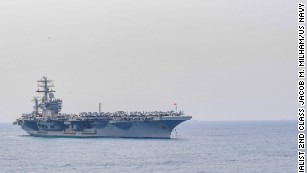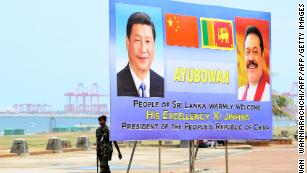By Steve George and Manveena Suri
New Delhi (CNN)The Seychelles is not typically associated with geopolitics. But beyond the white sandy beaches and tropical jungles, the tiny archipelago nation is emerging as a key player in India's battle to counter growing Chinese influence in the Indian Ocean.
Late last month, India and the Seychelles signed a revised agreement granting India permission to construct a military base on the Seychelles' Assumption Island, roughly 1,650 kilometers (1,025 miles) east of mainland East Africa.
The deal, which follows several years of diplomatic negotiations, will provide India with a crucial military staging point in what is fast becoming a critically strategic region.
In 2016, approximately 40 million barrels of oil per day -- equivalent to just under half of the world's total oil supply -- traveled through Indian Ocean entry and exit points, including the Straits of Hormuz, Malacca and Bab el-Mandeb.
India, which has more than 7,500 kilometers (4,700 miles) of coastline and sits at the very center of the Indian Ocean, is dependent on free and open access to those same shipping lanes for trade.
According to the Indian Ministry of Shipping, around 95% of the country's trade by volume, and 70% by value, comes via the Indian Ocean.
Chinese consolidation
India's attempts to better secure its access to the region mirrors a similar strategy deployed by its neighbor and long-standing rival China.
Under Chinese President Xi Jinping, China's naval reach has grown considerably, expanding far beyond its immediate coastline into areas not previously considered within its sphere of influence.
In July last year China established its first overseas military base in Djibouti, near the Bab el-Mandeb Strait, among the world's busiest shipping lanes and one of three crucial Indian Ocean arteries.
The strait, which is only 29 kilometers (18 miles) wide at its narrowest point, connects the Mediterranean Sea via the Suez Canal, and the Red Sea to the Gulf of Aden and the Indian Ocean beyond.
The opening of the Djibouti base was followed several months later by the country's controversial acquisition of the Hambantota port in Sri Lanka, just 22.2 kilometers (13.8 miles) by some estimates from the primary Indian Ocean sea lane that links the Malacca Straits to the Suez Canal.
Speaking to CNN, Malcolm Davis, a senior analyst at the Australian Strategic Policy Institute in Sydney, described the Hambantota deal -- which saw Sri Lanka grant China a 99-year lease on the port to service some of the billions in debt it owes to Beijing -- as part of a "determined strategy by China to extend its influence across the Indian Ocean at the expense of India."
"That port then gives them not only a strategic access point into India's sphere of influence through which China can deploy its naval forces, but it also gives China an advantageous position to export its goods into India's economic sphere, so it's achieved a number of strategic aims in that regard," said Davis.
Stoking fears
Earlier this month, China took the unusual step of denying accusations that it was "land grabbing" in another critical Indian Ocean seaport -- this time in the Maldives.
Like Sri Lanka, the Maldives has long been considered within India as a close regional ally. But in recent years, the country, led by President Abdulla Yameen, has drawn closer to China, inviting investment under Beijing's expansive "One Belt, One Road" economic initiative.
This has prompted concern in some corners, not least from the country's opposition leader, Mohamed Nasheed, who has stated publicly that China is "buying up the Maldives" under Yameen's rule.
Speaking to reporters last month, Nasheed claimed as much as 80% of the Maldives' foreign debt was owed to China, raising the prospect that the nation, much like Sri Lanka, could eventually be forced to hand over infrastructure to help pay off its debts.
Though China has denied the accusations, such views have helped to stoke fears in India of potential encirclement by China, and that analysts say, is playing into India's renewed push to consolidate regional alliances.
Speaking to CNN, Gurpreet Khurana, the executive director of India's National Maritime Foundation, said the new Seychelles deal was part of an Indian effort to safeguard territorial integrity.
"India has a primary area in the northern Indian Ocean and the secondary is the Indo-Pacific region. We (India) have interests that we have to preserve. With the Chinese going into the Indian Ocean in a big way, our strategic interests are expanding as well, and this is the only way India will be able to preserve itself," said Kurana.
No details confirmed
Though specific details of India's newly signed Seychelles agreement have not been released, a report by Janes suggests it includes provisions for a naval base and air strip.
A previous version of the accord, first proposed by Indian Prime Minister Narendra Modi in 2015, failed to takeoff, due to concerns over sovereignty and costs. Issues that this time around appear to have been ironed out. A statement released by the Indian Ministry of External Affairs sought to characterize the new, revised agreement as a joint endeavor.
 "India and Seychelles have drawn up a cooperation agenda that covers within its purview joint efforts in anti-piracy operations, and enhanced EEZ surveillance and monitoring to prevent intrusions by potential economic offenders indulging in illegal fishing, poaching, drug and human trafficking," read the statement.
"India and Seychelles have drawn up a cooperation agenda that covers within its purview joint efforts in anti-piracy operations, and enhanced EEZ surveillance and monitoring to prevent intrusions by potential economic offenders indulging in illegal fishing, poaching, drug and human trafficking," read the statement.
The move has stirred resistance in the Seychelles, however, where earlier this month, a group of 50 residents held a demonstration to protest the accord, citing a lack of transparency and environmental concerns.
The organizer of the protest, Ralph Volcere, told the official Seychelles News Agency that the island republic should not become involved in the "conflicts of superpowers."
"We need to remain nonaligned, friendly to all -- enemy to none," Volcere was quoted as saying.
Speaking to CNN, Arun Prakash, a retired four-star admiral and former Indian naval chief, refuted claims that the Seychelles agreement draws the island nation into a wider geopolitical rift.
"(What India is building in the Seychelles) is a facility, not a military base. It has not been our policy to set up military bases on foreign soil ... We were a colony for centuries, and after we became free, we do not want to do the same to another country. Setting up military bases is another form of colonialism," said Prakash.
 "In international relations, China's approach is called a realist approach. India is far more sensitive to the opinions to its neighbors. Ours is a softer one ... China has a lot of money to spend. If they want to build a base, they can do it overnight. We don't have the financial and technical means to do this like them," said Prakash.
"In international relations, China's approach is called a realist approach. India is far more sensitive to the opinions to its neighbors. Ours is a softer one ... China has a lot of money to spend. If they want to build a base, they can do it overnight. We don't have the financial and technical means to do this like them," said Prakash.
Close ties between India and the Seychelles stretch back several decades, though have tightened in recent years under Prime Minister Modi.
During a previous visit to the Seychelles by Modi in May 2015, the Indian leader outlined a vision for the Indian Ocean region with "collaboration as its backbone."
Under the banner of SAGAR (Security and Growth for All in the Region), a Modi-led initiative that seeks to develop better cooperation among Indian Ocean nations, Indian naval ships have helped to patrol the waters around the Seychelles, and in 2016, India installed a coastal surveillance radar system in the archipelago to gather and analyze intelligence.
The new agreement, which according to the Seychelles News Agency will be valid for an initial 20-year period once ratified, includes a clause that allows the Seychelles government to suspend operations at the base in certain circumstances it considers detrimental to its national interest, such as the outbreak of war.

No comments:
Post a Comment